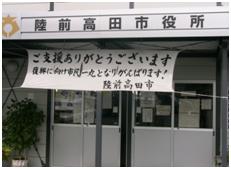Tomoko Izumikawa, a member of the Collaborative Translation Team "Transpinoff"

I have been working on translating articles submitted to Voices from the Filed by staff members of the volunteering groups working in the disaster affected area. For the first time after the disaster, I got a precious opportunity to visit the Tohoku area, see the situation with my eyes and listen to the sufferings of people with my ears. This is my report of visiting the Tohoku area for three days from October 17 to 19, 2011.
3. Hope lives on in a devastated seaside town
|
We visited the town of Rikuzentakata in Iwate Prefecture on the last day of our trip, October 19th. Rikuzentakata is located on the Pacific coast and its downtown was totally destroyed by the tsunami on March 11th. A beautiful pine forest called Takata-matsubara used to spread out on its coastline protecting the city from storms since the Edo era. The entire forest of 70,000 pine trees was, however, swept away by the tsunami, except for a single tree. The tree miraculously survived the tsunami and local people have named it the “Lone Pine of Hope”i , as a symbol of restoration.
I had the opportunity to speak with Ms. M, a woman in her twenties, who currently works at the temporary office of the Rikuzentakata Sightseeing and Products Association, about her experience in the disaster.
“On that day, I was working at the Sightseeing and Products Center which was located on the seaside. I was not sure where our designated evacuation place was, so I just fled to a hill. Later I learned that the evacuation place was a gymnasium. But the people who fled to the gymnasium were all washed away and killed. My house was also washed away, and nothing remains. But fortunately my husband was safe, because he was on his delivery job in the inland area, and his parents also survived. I think we are lucky enough. I appreciate all the help offered to us since the disaster. Please continue with your support to Rikuzentakata!”
In spite of the harsh experience and all the difficulties she still faces, she cheerfully expressed her dedication to Rikuzentakata and its recovery. Does her strength come from having survived the cruel reality that a split-second decision divided life and death? Her bright smile overwhelmed me.
All the victims I met during this trip seemed to have a light of hope in their hearts. I was impressed by their attitudes and the expressions in their eyes when they talked about their hopes to stand up on their own feet, work for other people, and revive their town. Each of them must have a long and rugged path ahead to recovery. But I realized that, even in times of great hardship, people continue to move forward as long as they have hope, and that they sincerely want to help other people, not just themselves. I was moved by their undaunted spirit.
|

|
|
"Lone Pine of Hope” and a view from the opposite shore (Lower)
|

|

|

|

|
|
Rikuzentakata City Hall
“Thank you very much for your support.
We, all the citizens, will work together towards recovery! Rikuzentakata City”
|
iDespite many efforts to preserve the “Lone Pine of Hope”, the Japan Greenery Research and Development Center based in Tokyo announced on December 12th , 2011, that salt water had rotted most of the tree's roots and that it cannot be saved. However, four branches, which had been taken from the Lone Pine and grafted in case it dies, is successfully growing and relaying its life to the new generation.